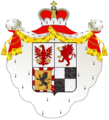Principality of Bayreuth
|
Territory in the Holy Roman Empire |
|
|---|---|
| Bayreuth | |
| coat of arms | |
| map | |
| Form of rule | principality |
| Ruler / government | Margrave |
| Today's region / s |
DE-BY
|
| Reichskreis | Franconian Empire |
| Capitals / residences | Bayreuth , Kulmbach |
| Denomination / Religions | Roman Catholic until 1525, since then Lutheran |
| Language / n |
German
|
| Incorporated into |
Kingdom of Bavaria (1810)
|
The Principality of Bayreuth , also Markgraftum Brandenburg-Bayreuth , was an imperial immediate territory of the Holy Roman Empire in the Franconian Empire , which was ruled by the Franconian branches of the House of Hohenzollern . Until 1604 the Plassenburg in Kulmbach was the residence of the principality. It was therefore also called the Principality of Kulmbach or the Margraviate of Brandenburg-Kulmbach . The principality was officially listed under this name in the imperial registers until 1806 . After Margrave Christian von Brandenburg-Bayreuth took over the residence ofKulmbach had moved to Bayreuth , the territory was initially referred to as the Principality of Kulmbach-Bayreuth .
history
Origin and first years
The Principality of Bayreuth developed from the Upper Mountain region of the Burgraviate of Nuremberg . Together with the lower mountainous part of the burgraviate it formed the Franconian ancestral lands of the Hohenzollern .
After the Hohenzollern 1415/1417 with Burgrave Friedrich VI. of Nuremberg had come into the hereditary possession of the Mark Brandenburg , they used their newly acquired title of Margrave in their previous Franconian possessions. With the sale of the Nuremberg Burggrafenburg to the imperial city of Nuremberg in 1427, the castle count's chapter in the history of the Hohenzollern ended. For their Franconian territories the designation Margraviate became common.
The final separation into two independent territories finally took place in 1486 after the death of Albrecht Achilles . According to the Dispositio Achillea issued by Albrecht in 1473 , the Hohenzollern territory in Franconia was divided between his two younger sons. The allocation of the two parts of the country was decided by lot. It occurred Siegmund von Brandenburg-Kulmbach the obergebirgische to part of the country, later Principality of Kulmbach. His brother Friedrich II. Von Brandenburg-Ansbach received the future principality of Ansbach with the lower mountainous country .
Modern times and the end
In 1542, Margrave Albrecht Alcibiades moved the seat of government from the Kulmbacher Plassenburg (which was expanded into a fortress from 1530) to Bayreuth. From 1604 the country was called the Principality of Bayreuth .
Although the Principality of Kulmbach-Bayreuth was ruled several times in personal union with the Principality of Ansbach (1495–1515, 1557–1603 and 1769–1791), it remained a legally independent territory until the end of the Holy Roman Empire . On January 16, 1791, Margrave Christian Friedrich Karl Alexander ceded his principalities of Ansbach-Bayreuth to the Prussian state in a secret treaty for a lifelong annual annuity of 300,000 guilders . Karl August von Hardenberg initially administered the principalities together. During the Fourth Coalition War , the Principality of Bayreuth was occupied by French troops in the autumn of 1806 . After the devastating defeat, Prussia had to cede the Franconian territory to the French Empire in the Peace of Tilsit in 1807. While maintaining the Prussian administrative structures, it was initially placed under a French military administration. Emperor Napoleon only viewed the principality as a pays reservé , i.e. an area that he kept in reserve for future barter transactions. Already in 1808 he offered it to the Congress of Erfurt to the Kingdom of Bavaria for the price of 25 million, and later for 15 million francs on. Reluctantly at first, the kingdom paid the requested sum in 1810. When Bavaria took possession of it on June 30 of the same year, the existence of the Principality of Bayreuth ended.
The Margraves of Brandenburg-Kulmbach (or Bayreuth since 1604)
| Margrave | from | to | Remarks | image |
|---|---|---|---|---|
| Johann | 1398 | 1420 | Johann was the older son of Burgrave Friedrich V of Nuremberg , who in 1398 divided the burgraviate into an upper and a lower bourgeois principality among his sons. Johann chose the Plassenburg in Kulmbach as the place of his residence . | |
| Friedrich I. | 1420 | 1440 | Friedrich I was the younger brother of Johann III. He was still one of the burgraves of Nuremberg . After the division he received from his father, the burgrave Friedrich V of Nuremberg , the lower-bourgeois principality of Ansbach in 1398 and after the death of his brother also the upper-bourgeois principality of Kulmbach. In 1415 he was also awarded the dignity of Elector of Brandenburg . |

|
| Johann the Alchemist | 1440 | 1457 | Johann the Alchemist was the eldest son of Frederick I of Brandenburg . He had no male offspring and renounced the government in 1457. | |
| Albrecht Achilles | 1457 | 1486 | Albrecht Achilles took over the Principality of Kulmbach as Margrave of Ansbach (since 1440) after the abdication of his brother Johanns the Alchemist . When his eldest brother Friedrich der Eiserne abdicated as Elector of Brandenburg in 1470 , he succeeded him and thus united the entire property of the Hohenzollern family in one hand. |

|
| Siegmund | 1486 | 1495 | Siegmund was the youngest son of Albrecht Achilles . He died unmarried and without offspring. | |
| Friedrich II. | 1495 | 1515 | Friedrich II was the second son of Albrecht Achilles . He had received the Principality of Ansbach in 1486 and after the death of his brother Siegmund also took over the Principality of Kulmbach. Because of his lavish lifestyle, he was deposed by his sons in 1515 and imprisoned at the Plassenburg for 13 years . |

|
| Casimir | 1515 | 1527 | Casimir was the eldest son of Friedrich II. He disempowered his father in 1515. He also ruled over the Principality of Ansbach on behalf of his brother George the Pious . |

|
| George the Pious | 1527 | 1541 | Georg was a son of Frederick II , together with his brother Casimir, he ousted their father in 1515. He took over the Principality of Ansbach , but let his brother administer it in his absence. When he died, he took over the affairs of government in the Principality of Kulmbach for his underage son Albrecht Alcibiades until he came of age. It is not known whether Georg ever visited Bayreuth.
He sympathized early on with the teaching of Martin Luther , whom he met personally in Wittenberg and with whom he corresponded until the end of his life. As early as 1529 he was one of the princes who professed Luther's teachings at the Diet in Speyer . The Schwabach articles written by him and the Nuremberg people from 1528 formed the basis for the Reformation in his countries. |

|
| Albrecht Alcibiades | 1527/ 1541 |
1554 | Albrecht's uncle Georg managed the Principality of Kulmbach until he came of age . During his lifetime Albrecht was nicknamed "Bellator", the warrior. In the Schmalkaldic War (1546/47) he changed fronts several times, which is why he was nicknamed Alcibiades . In the Second Margrave War he fought against his neighbors, including the bishopric of Bamberg and the bishopric of Würzburg , for supremacy in Franconia. He had the ambitious goal of establishing a Duchy of Franconia under the rule of the Hohenzollern. In 1553 the so-called federal army put an end to the militant margrave. He was ostracized and fled to his sister's family, where he stayed until his death. |

|
| 1554 | 1557 | The imperial ban on Albrecht Alcibiades was followed by an interregnum . | ||
| Georg Friedrich the Elder | 1557 | 1603 | As the only son of George the Pious , Georg Friedrich I had been Margrave of Ansbach from 1543 and succeeded Albrecht Alcibiades as Margrave of Kulmbach in 1557 . For the increasingly depressed Prussian Duke Albrecht Friedrich , he took over the guardianship as his closest relative in 1577. Georg Friedrich I managed to consolidate the financial system. Franconian officials who were seen as exemplary were sent to Prussia to implement appropriate reforms there. With Georg Friedrich I. the older line of the Franconian Hohenzollern died out. |

|
| Christian | 1603 | 1655 | Christian was a son of the Brandenburg Elector Johann Georg . With his takeover of the Principality of Kulmbach he founded the younger line of the Franconian Hohenzollern. He chose Bayreuth as the new royal seat . |

|
| Christian Ernst | 1655 | 1712 | Christian Ernst, first-born son of Erdmann August, who died in 1651 , and Christian's grandson, followed at a young age as margrave. He embarked on a military career and was the only Bayreuth margrave to gain influence in imperial politics. His career carried him up to the rank of Imperial Field Marshal . |

|
| Georg Wilhelm | 1712 | 1726 | Georg Wilhelm was the only son of Christian Ernst . As Hereditary Prince, he laid out the suburb of St. Georgen am See near Bayreuth and founded the Red Eagle Order , which is closely associated with it . The hunting castles Kaiserhammer and Thiergarten , the Hermitage and Neustädtlein Castle (today the municipality of Eckersdorf ) were also built by him. He remained without male offspring. |

|
| Georg Friedrich Karl | 1726 | 1735 | Georg Friedrich Karl was the eldest son of Christian Heinrich and thus a great-grandson of Margrave Christian . The heavily indebted father was originally supposed to waive his inheritance claims in the Schönberg Treaty in favor of Prussia. The reign of Georg Friedrich Karl was marked by his concern for religious issues, he also promoted school and social institutions. He converted the former Himmelkron monastery into a castle. |

|
| Friedrich III. | 1735 | 1763 | Friedrich III. was the son of Georg Friedrich Karl . He was considered a popular margrave who strove for science and art. He carried out extensive construction work together with his wife, Margravine Wilhelmine, with the new buildings of the New City Palace , the Margravial Opera House , the Sanspareil Rock Garden , the Fantaisie Palace and the expansion of the Hermitage . The couple had a daughter (Duchess Elisabeth Friederike Sophie ), whose marriage failed and remained childless. |

|
| Friedrich Christian | 1763 | 1769 | Friedrich Christian was a son of Christian Heinrich and thus an uncle of Friedrich III. He drastically reduced the court and lived a rather withdrawn life, which earned him the reputation of an eccentric. With him, the line that Margrave Christian had founded died out. |

|
| Christian Friedrich Karl Alexander | 1769 | 1791 | Christian Friedrich Karl Alexander was a son of the Ansbach margrave Karl Wilhelm Friedrich . He was Margrave of Ansbach from 1757 . For the first time after 1603 the two principalities of Bayreuth and Ansbach came together again in a personal union. On January 16, 1791, the last margrave ceded his principalities to the Prussian state in a secret treaty for a lifelong annual annuity of 300,000 guilders. He married Elizabeth Craven for the second time and went with her as a private citizen to England, where he dedicated himself to breeding horses until he was old. |

|
geography
Territorial inventory
With the Regensburg partition agreement in 1541, some sub- mountain areas were finally annexed to the Principality of Kulmbach. Since then, these have formed the smaller Unterland , while the previous area of the principality was, in contrast, called the Oberland . The territorial existence of the area created in this way only changed insignificantly due to settlement agreements with neighboring areas or smaller acquisitions.
Despite minor successes (e.g. through the acquisition of Eschenau, which was sold to the Principality of Bayreuth by Nuremberg owners in 1751) it was never possible to connect the two parts of the country with a land bridge. Pushed-in Bamberg and Nuremberg areas continued to divide the principality into two parts. This turned out to be very disadvantageous and in some cases also led to different developments in the two parts of the country.
For example, the nobility of the Bayreuth Unterland was able to maintain its imperial immediacy until the end of the 18th century, while the nobility of the Oberland did not. At the end of the 18th century, the Oberland area of the principality was already in a relatively compact and closed form. The lowlands, on the other hand, was divided into many separate areas. The various condominiums with other territories formed a further complication of the territorial existence in the lowlands .
Oberland
The Oberland was mainly in the area of today's Bavarian administrative district of Upper Franconia . Outside of Upper Franconia, there were mainly significant parts of the Upper Office Neustadt am Kulm (in the area of today's Upper Palatinate ) and the Upper Office Easterohe (with the Hohenstadt exclave ) in what is now Central Franconia . The Oberland included u. a. the Fichtel Mountains , large parts of the Franconian Forest , as well as parts of the Muggendorfer Mountains (i.e. today's Franconian Switzerland ).
It was a mountainous and wooded area, the poor soil conditions of which did not particularly favor agriculture. In addition to the extensive forests, the great wealth of the Oberland consisted of its mineral resources . Numerous ore deposits led to the construction of many mines , such as B. in the Franconian Forest or in the southern Fichtel Mountains.
Using the example of a village, the administrative history of the Oberland is presented in the article Schweinsbach .
In the middle of the 18th century, the upper administrative level of the Oberland consisted of a total of eleven administrative areas:
- Landeshauptmannschaft Hof
- District administration Bayreuth with the exclaves Streitberg and Hetzelsdorf as well as the Vogteiamt Thuisbrunn
- District administration Kulmbach
- Amtshauptmannschaft Wunsiedel (the so-called Sechsämterland )
- Oberamt Creußen
- Head Office Gefrees
- Oberamt Lichtenberg (1778 to the Landeshauptmannschaft Hof)
- Oberamt Neustadt am Kulm (1778 to the administration of Bayreuth)
- Oberamt Osternohe (1766 to the Oberamt Pegnitz)
- Oberamt Pegnitz
- Schauenstein Oberamt ( Oberamt only from 1747 to 1772, otherwise part of the Kulmbach administration)
- Oberamt Stockenroth
At the end of the principality's independence, there were only the following seven administrative areas in the Oberland:
- Landeshauptmannschaft Hof
- Bayreuth administration
- District administration Kulmbach
- District administration Wunsiedel
- Oberamt Creußen
- Oberamt Pegnitz
- Head Office Gefrees
Unterland
The lowlands lay almost exclusively in the area of today's Bavarian administrative district of Middle Franconia . In the east there were only the exclave Neuses an der Regnitz and a few other smaller peripheral areas in the administrative district of Upper Franconia . In the far west, the area of the Frauental monastery in Hohenlohe partially extended into what is now Baden-Württemberg .
Compared to the Oberland area, the Unterland was quite fertile. Favorable soil conditions allowed intensive agriculture here, which ensured a certain prosperity for the population.
The upper administrative level of the Unterland consisted of a total of six administrative areas in the middle of the 18th century:
- State administration Neustadt an der Aisch
- Administrative Authority Erlangen
- Oberamt Baiersdorf
- Oberamt Eschenau
- Oberamt Hoheneck
- Oberamt Neuhof
education
The Latin school (today Markgraf-Georg-Friedrich-Gymnasium) was founded in Kulmbach as early as 1393 - even before it was a royal seat - making it one of the oldest schools in Germany (see list of the oldest schools in the German-speaking area ). But the margraves of Brandenburg-Bayreuth also promoted education in their margraviate at an early stage. In 1546, Margrave Albrecht Alcibiades founded a grammar school in Hof . Today's Jean-Paul-Gymnasium emerged from the school . A university was founded in the royal seat of Bayreuth in 1742 and relocated to Erlangen the following year due to problems between the citizens and students . The name of the university - Friedrich-Alexander-Universität Erlangen-Nürnberg - still reminds of the two margraves of Zollern, Friedrich and Alexander .
Buildings and residences
Lively construction activities took place in the 18th century , as did in neighboring territories (e.g. under the Würzburg Prince-Bishop Friedrich Karl von Schönborn-Buchheim ). The so-called margrave style , one of whose most important representatives is Johann David Steingruber (1702–1787) as the builder of numerous churches, is considered characteristic. The representative buildings of the principality in Bayreuth include the Hermitage , the opera house , the New Palace including the courtyard garden and the formerly independent suburb of St. Georgen am See , which was built according to plan by Georg Wilhelm in baroque symmetry . The Kaiserhammer hunting lodge is important in the wider area . The Margravine Wilhelmine also arranged for the Sanspareil rock garden to be built near Wonsees . Architects of the Margrave couple Friedrich III. and Wilhelmine were Joseph Saint-Pierre and the young Carl von Gontard .
Plassenburg in Kulmbach , first mentioned in 1135, residence until 1542/1603
Old castle in Bayreuth , built in 1455, residence from 1603 to 1753
New castle in Bayreuth, built from 1753, residence until 1791
Margravial castle in Erlangen , built from 1700
economy
Particular economic achievements in the 18th century are the introduction of sheep breeding in the region and the establishment of the Ansbach faience factory . The last Margrave Karl Alexander founded the Hochfürstlich-Brandenburg-Anspach-Bayreuthische Hofbanco in 1780 .
In the early days of the principality, Margrave Friedrich II was considered particularly wasteful, who wanted to keep up with his rich relatives in Prussia and Poland and thus gave two of his sons the opportunity to disempower and imprison him. The Margrave of Ansbach, Karl Wilhelm Friedrich , spent 10% of the financial resources on his extravagant hunting passions and left his son, who inherited the Bayreuth principality, an overwhelming debt burden. This was certainly also the reason for the sale of the principalities to Prussia.
Wars
- Hussite Wars 1419–1434 / 39
- Bavarian War (1420-1422)
- First Margrave War 1449–1450
- Bavarian War (1459–1463)
- War of the Landshut Succession 1504/05
- Franconian War 1523
- German Peasants' War 1525
- Second Margrave War 1552–1555
- Thirty Years War 1618–1648
Waiting towers
A sophisticated observation and signaling system with guard towers was in place in the margrave to provide advance warning in the event of attacks . Such signal posts gave up, among other things
- the Katharinenberg near Wunsiedel
- the castle Thierstein in Thierstein
- the Weißenstein near Stammbach
- the Plassenburg near Kulmbach
- the Wartberg near Hof
- the Rauhen Kulm near Neustadt
- the Schneeberg , the so-called Backöfele
- the Sophienberg near Bayreuth
The towers were manned by guards at times. A fire was lit in case of danger. In this way, the alarm could be displayed to the next item without delay. An early alarm system was described in a maintenance order in 1498 . In the territory of the principality, place names point to other waiting areas and waiting towers, such as the Hohe Warte near Bad Berneck , the Wartberg near Grafenreuth or the Hohe Wart in Bayreuth.
coat of arms
The coat of arms of the Hohenzollern in the Principality of Bayreuth has undergone considerable changes over the centuries. It consisted more and more of various elements that represented the increasingly extensive demands of the family. The Franconian Hohenzollerns also increasingly included the claims of their Prussian relatives in their coat of arms.
The coat of arms of the Hohenzollern or the County of Zollern is silver and black quartered . As an increased coat of arms it appears alternating with the coat of arms, which symbolizes the burgraviate of Nuremberg : a black double-tailed lion on a golden background (coat of arms of the Counts of Raabs ). The lion wears a red crown. The additional electoral dignity by the Mark Brandenburg brought the Brandenburg eagle , a red eagle on a silver background , as a further coat of arms . According to Bernhard Peter, the number of coat of arms fields rose to 33 by 1769. This included claims to previously independent duchies or bishoprics, but these were primarily raised by the main line of the Hohenzollerns . In heraldry, this final form represents a record from 1769.
Convention thaler from 1766 with heraldic shield
Margravial coat of arms in Hofer Ludwigstrasse
More people
- Sophie Charlotte of Brandenburg-Bayreuth (1713–1747), by marriage Duchess of Saxony-Weimar and Saxony-Eisenach
See also
literature
in alphabetical order by authors / editors
- Sylvia Habermann: Bayreuth garden art: The gardens of the Margrave of Brandenburg-Culmbach in the 17th and 18th centuries = Green Series 6. Wernersche Verlagsgesellschaft , Worms 1982, ISBN 978-3-88462-012-0 .
- Georg Paul Hönn : Principality of Bayreuth . In: Lexicon Topographicum of the Franconian Craises . Johann Georg Lochner, Frankfurt and Leipzig 1747, p. 223-310 ( digitized version ).
- Friedrich Gottlob Leonhardi : Earth description of the Franconian principalities of Bayreuth and Anspach. 1797 ( online ).
- Johannes Müllner: The annals of the imperial city of Nuremberg from 1623, Part II: From 1351-1469. Nuremberg 1972.
- Gerhard Rechter: The imperial tax register of 1497 of the Principality of Brandenburg-Ansbach-Kulmbach below Gebürgs (2 volumes). Publication of the Society for Family Research in Franconia . Nuremberg 1985.
- Gerhard Rechter: The Imperial Tax Register of 1497 for the Principality of Brandenburg-Ansbach-Kulmbach above Gebürgs. Publication of the Society for Family Research in Franconia . Nuremberg 1988.
- M. Spindler, G. Diepolder: Bavarian History Atlas . Munich 1969.
- M. Spindler, A. Kraus: History of Franconia up to the end of the 18th century. Munich 1997, ISBN 3-406-39451-5 .
- Gerhard Taddey (ed.): Lexicon of German history . Events, institutions, people. From the beginning to the surrender in 1945. 3rd, revised edition. Kröner, Stuttgart 1998, ISBN 3-520-81303-3 .
Web links
Individual evidence
- ↑ Karl Müssel: Bayreuth in eight centuries , S. 47th
- ↑ Karl Müssel: Bayreuth in eight centuries , page 51 et seq.
- ↑ Karl Müssel: Bayreuth in eight centuries , S. 54th
- ↑ Compare the list of the Hohenzollern family .
- ↑ Article in the Frankenpost , November 22, 2008 ( page no longer available )
- ↑ www.welt-der-wappen.de .















